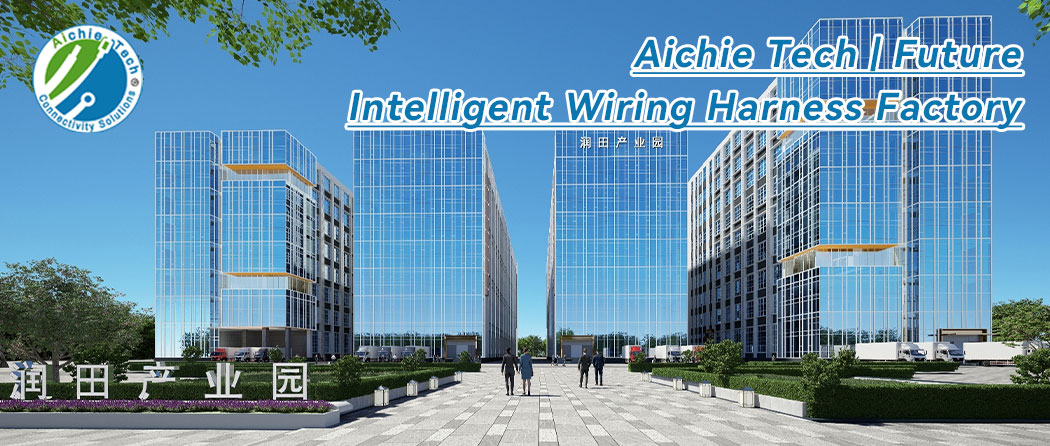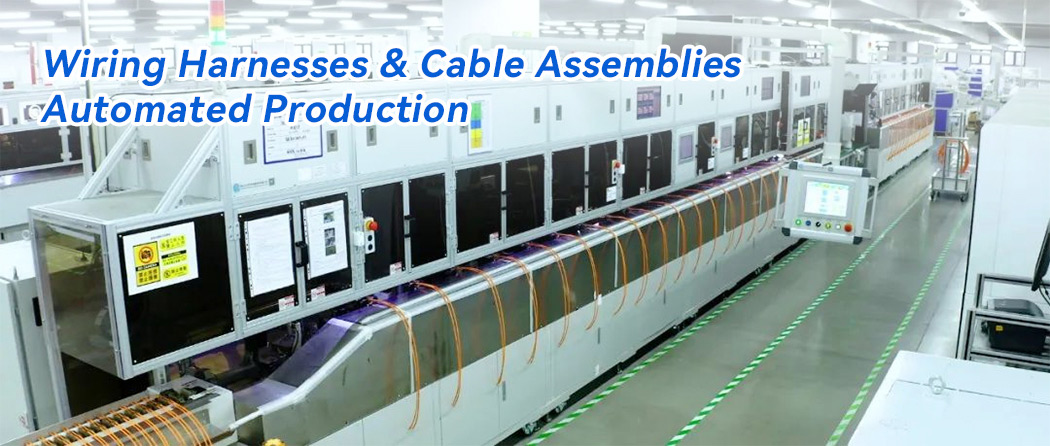In modern industrial fields such as automobiles and electronics, wire harnesses, as the "neural network" connecting various components, their production quality and efficiency directly affect the performance of terminal products. Traditional wire harness factories often encounter pain points such as cumbersome production processes, large quality fluctuations, and slow response speeds. However, the emergence of intelligent wire harness factories is reconfiguring the core logic of wire harness manufacturing with their characteristics of interconnection, flexibility, and self-adaptability. It is not merely an automated upgrade, but rather a leap from "passive execution" to "active optimization" through data-driven and system collaboration, becoming a new frontier in manufacturing systems in specific fields.

From Automation to Intelligence: Redefining Wire Harness Manufacturing
In traditional wire harness production, automation is not a new thing - automatic cutting machines and crimping machines have long been widespread, but these devices are mostly limited to mechanical repetition of a single process, like individual "information islands". When it is necessary to switch product models, workers need to manually adjust the parameters. When a certain piece of equipment suddenly malfunctions, the entire production line may come to a standstill. When customer demands change, the production scheduling plan is often delayed by several weeks. This kind of "isolated automation" is essentially still a simple replacement for human labor and is difficult to meet the modern demands for a wide variety of wire harness products, small batches and high precision.
The intelligent wiring harness factory has completely broken through this limitation. Based on full-chain interconnection, it incorporates equipment, materials and personnel involved in processes such as cutting, crimping, assembly and inspection into a unified system, and realizes the deep integration of physical assets and digital processes through cyber-physical systems (CPS). For instance, the specification parameters of the wires can be directly transmitted from the digital design end to the cutting equipment, the inventory data of the terminals is linked in real time with the assembly progress, and the inspection data is automatically fed back to the design end to optimize the process. This integration not only eliminates information gaps but also endows the entire production network with "learning capabilities" - by continuously analyzing historical and real-time data, the system can independently optimize wiring paths, adjust equipment parameters, and even predict process defects, achieving a qualitative change from "production according to instructions" to "autonomous optimization of production".
It is worth noting that the intelligent wiring harness factory is not an "ultimate form" achieved overnight, but rather a dynamic evolution process. As the requirements for high-temperature resistance, lightweight and integration of wiring harnesses in fields such as new energy vehicles and smart home appliances continue to rise, factories can continuously adapt to new technical standards and market demands by iterating algorithm models and upgrading sensor networks. This "growth potential" is precisely the core advantage that distinguishes it from the one-time transformation of traditional factories.

Five core features: Unlock the efficiency code for wire harness manufacturing
The unique value of an intelligent wiring harness factory is reflected in the synergy of five major features: interconnection, optimization, transparency, foresight, and agility. These features support each other, jointly building an efficient, reliable and flexible production system, precisely addressing the pain points of traditional wire harness manufacturing.
Interconnection: Unblocking the data closed loop of "nerve endings"
Interconnection is the cornerstone of intelligent wire harness factories. In traditional factories, key data such as wire length errors and terminal crimping forces need to be recorded manually, resulting in lagging information transmission and easy distortion. Smart factories achieve a full-element networking of "equipment - materials - personnel - environment" by deploying sensors on equipment such as cutting machines, crimping machines, and inspection benches, and installing RFID tags on material racks. For instance, when a roll of wire enters the workshop, the RFID tag will automatically trigger the system to update the inventory. Each time the cutting machine completes a cut, the length data will be uploaded to the cloud in real time. Workers receive work orders through intelligent terminals, and the operation records are synchronized back to the system. This all-domain interconnection forms a complete data closed loop, providing real-time and accurate "raw materials" for subsequent optimization and decision-making.
Optimization: Eliminate waste and errors through automation
The quality and efficiency of wire harness production are often constrained by the stability of manual operation. For instance, manual wiring is prone to missed or incorrect connections, and deviations in crimping force may lead to poor contact. The intelligent wiring harness factory minimizes human intervention through automated work processes and intelligent algorithms: the automatic wiring robot precisely arranges wires based on digital models, the intelligent crimping machine automatically adjusts pressure and time according to the material of the terminals, and the AI visual inspection system can identify defects such as damaged insulation layers and skewed pins within 0.1 seconds. After a certain automotive wiring harness enterprise introduced this system, not only did its production capacity increase by 30%, but the defective product rate also dropped from 5% to 1.5%, confirming the practical value brought by optimization. Meanwhile, by analyzing the energy consumption data of the equipment, the system can automatically adjust the operating periods of high-energy-consuming devices, achieving an energy efficiency improvement of over 15%.
Transparency: Make data a "touchable" basis for decision-making
The management of traditional wire harness factories often falls into a "black box predicament" : production progress is summarized through reports, equipment status is judged based on experience, and problem traceability requires checking paper records. The intelligent wiring harness factory makes the entire process status "transparent and visible" through real-time data visualization. Managers can directly view the production progress of each workstation, equipment OEE (Overall Efficiency), material inventory warnings and other information on the central control screen. When quality fluctuations occur in a certain batch of terminals, the system can automatically trace back to the full chain data such as the supplier, the time of entry into the warehouse, and the usage process to quickly locate the root cause. This transparency not only enhances decision-making efficiency but also enables front-line workers to receive quality feedback in real time through their workstation terminals, thus forming a virtuous cycle of "data-driven improvement".
Future: From "Fire-fighting Response" to "Preventive Management"
In the production of wire harnesses, sudden equipment failures and material shortages are the main reasons for work stopps. The intelligent wiring harness factory transforms passive response into proactive prevention through predictive algorithms. Based on historical data such as equipment vibration, temperature and current, the system establishes a fault prediction model and issues a 24-hour early warning of bearing wear in the crimping machine. By analyzing the order trend and inventory consumption rate, it automatically triggers replenishment reminders for materials such as terminals and sheaths to prevent production halts due to material shortages. After a certain home appliance wiring harness enterprise introduced this function, the unplanned downtime of its equipment was reduced by 60%, and the inventory turnover rate increased by 25%, significantly lowering the risk of production fluctuations.
Agility: Respond quickly to market demands for multiple varieties and small batches
With the intensification of personalized consumption trends, the demand for customized wiring harness products is increasing day by day - different configurations of the same vehicle model may require more than ten wiring harness solutions, and the same brand of home appliances update dozens of wiring harness designs every year. Traditional factories need several days to adjust their production lines, while intelligent wire harness factories, with their flexible configuration capabilities, can achieve "minute switching". When a new wiring harness design scheme is introduced into the system, digital twin technology will simulate the production process in the virtual space and automatically generate equipment adjustment parameters. The robot automatically changes fixtures according to the new program, and the detection system synchronously updates the recognition standards. This agility enables factories to respond quickly to customer demands. For instance, the delivery cycle of a wiring harness order from a certain new energy vehicle manufacturer was shortened from two weeks to three days, significantly enhancing its market competitiveness.
More than Efficiency: Reshaping the Ecological Value of Wire harness Manufacturing
The significance of an intelligent wiring harness factory goes far beyond the improvement of production efficiency. It has restructured the ecological relationship of wire harness manufacturing by integrating the data flow between the production end, the supply chain and the client end. At the supply chain level, factories can share demand forecast data with upstream terminal and wire suppliers to achieve JIT (Just-In-Time) supply and reduce inventory costs for both parties. On the client side, through digital twin technology, customers can preview the production process of wire harnesses online and even offer real-time modification suggestions, forming a closed-loop collaboration of "design - production - feedback".
This ecological synergy capability enables wire harness factories to transform from "mere producers" into "value partners". For instance, when a car manufacturer launches a new model, the intelligent wiring harness factory can analyze its electrical architecture data to optimize the wiring harness design plan in advance and shorten the vehicle R&D cycle. When home appliance enterprises are confronted with sudden orders, factories can quickly adjust their production schedules to ensure the timeliness of delivery.
With the in-depth advancement of Industry 4.0, the evolution of intelligent wire harness factories is still ongoing. In the future, with the integrated application of technologies such as 5G and edge computing, its autonomous decision-making ability and cross-factory collaboration ability will be further enhanced. However, no matter how technology evolves, its core remains: using data as a bond to make manufacturing systems better understand demands, more adaptable, and more resilient, ultimately injecting continuous growth momentum into the wire harness manufacturing industry in the rapidly changing market.